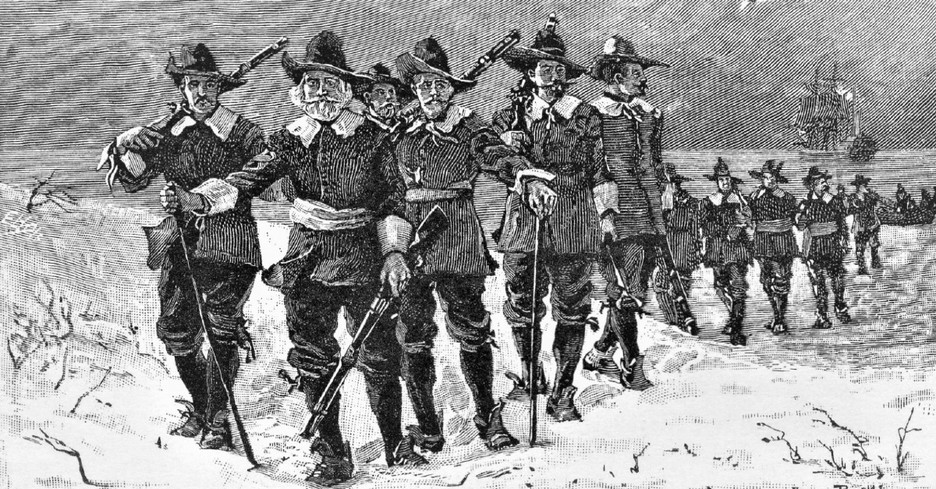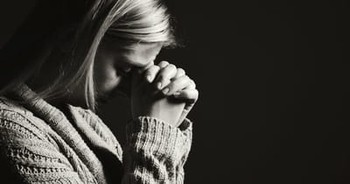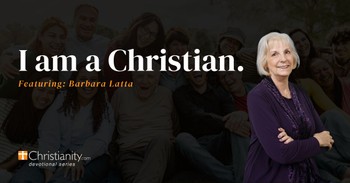
Why did the Puritans settle in America? What makes a group of people leave everything they know and love, the only land they’ve ever known, to travel into the unknown?
We’re so accustomed to the story of America’s first settlers that we sometimes imagine them to be people very unlike ourselves, with no fears, longings, or concerns about sailing to an unsettled land across the sea.
But, while cultures and languages change over time, the human heart is remarkably the same from generation to generation. A deeper understanding of the complexity of what the Puritans initiated and endured can help us understand ourselves.
Who Were the Puritans?
The Puritans were a group of people living in England in the late 16th century. Like many of us, they cared deeply about obeying God and living according to the Bible.
This group of people became uncomfortable with certain traditions and practices of the Church of England and advocated for change. When the King of England was also the head of the Church of England, and civil war was occurring in England, advocating for changes could be divisive.
The name “Puritans” was given contemptuously by people who saw them as troublemakers. The Church of England had already distinguished itself from the Roman Catholic Church and saw itself as a kind of reformation of that institution. The Puritans believed too many of the Roman Catholic practices remained. People also referred to the Puritans as “Precisionists,” which gives an idea of how others viewed them.
A group of Puritans left the church and declared themselves “Separatists.” This group became the Pilgrims, who left Europe and landed on Plymouth Rock in what is now known as New England.
The difference between the two groups is that one group of Puritans sought not to separate and instead wanted to call for reform from within the church. They desired to be heard. They wanted to remain within the Church of England and spearhead the purging of practices and traditions not absolutely rooted in Scripture.
Puritans were largely students of John Calvin’s reformed theology. They valued preaching and highlighted the Supremacy of God. They held to a literal belief of Scripture and were minimalistic in worship and sanctuary style. Many Puritans were well-educated, articulate, and skilled at writing.
The church still experiences conflict over adherence to Biblical teachings today, especially over socially divisive issues. And again, some try to make changes from within denominations while others decide to separate and create new ones.
Why Did the Puritans Leave Europe?
It’s not hard to understand that in a monarchy where the king is also head of the church, theological disagreements and calls for change can easily translate into threats of treason. King James I and his son, King Charles I, were hostile toward the Puritans. This resulted in a distinct unwelcome feeling in their land and the constant specter of persecution. It became harder and harder to earn a living, maintain friendships, or steer clear of legal trouble.
They left England and sailed for the New World, landing in Massachusetts but eventually spreading to the other colonies, aiming to create the “city of God” they envisioned from their understanding of God’s Word.
During this “Great Migration,” some 80,000 Puritans left Europe to travel to the New World. The initial settlers were primarily young men, often skilled in the trades and well off enough to afford passage across the Atlantic. Our image from the first Thanksgiving suggests small groups coming across the ocean. In fact, many Puritan settlers came in large groups. For instance, the Winthrop Fleet in 1630 consisted of 11 ships transporting over 700 Puritans to the New World.
Where Did the Puritans Arrive in America?
Initially, Puritans landed in Massachusetts in Plymouth, including the separatist Puritans or Pilgrims, famously remembered for the first Thanksgiving. This band of around 100 landed in 1620. But, settlers moved beyond New England to other areas along the Eastern Coast and Bermuda. (There were also English settlers who remained faithful to the Church of England, including the group who landed in Jamestown.)
While we celebrate religious freedom in America, we don’t necessarily share the Puritans’ exact vision. The Puritans sought the freedom to worship in a way they believed aligned with Scripture. Still, they weren’t looking to create a world that tolerated deviances from their understanding of religious practice.
This strict view resulted in different colonies forming when people discovered they had variations of theology. My home state of Rhode Island is an example of this. Roger Williams dared to suggest there be a separation of church and state, which didn’t sit well with some Puritans’ concept of the “city of God.” Consequently, Roger Williams was sent to settle a different part of the territory.
Modern believers haven’t lost the idea of creating a “city on a hill” to point toward the “city of God,” but reasonable Christians differ on how they think that works out and what form it can take. Some hold a view similar to the Puritans that it can combine church and government leadership. Others take a view closer to Roger Williams’s view, that church and state should remain separate and that the church alone is the purview of God’s rule until Jesus’ return (except where Christians wield voluntary influence).
When Did the Puritans Celebrate the First Thanksgiving?
Traditionally, we celebrate what many believe was the first Thanksgiving. This feast followed the settlers’ first harsh year of survival and initial harvest. The Wampanoag tribe, a tribe of indigenous people, reportedly celebrated with the Pilgrim Puritans, sharing a meal and engaging in athletic games.
Of course, indigenous people already had their own celebratory harvest traditions before the “first Thanksgiving” with the settlers. The Plimoth/Pawtuxet Museum website states that in the only surviving record of the celebration, Pilgrim Edward Winslow writes this:
“Our harvest being gotten in, our governor sent four men on fowling, that we might after a more special manner rejoice together, after we had gathered the fruits of our labors. They four in one day killed as much fowl as, with a little help beside, served the Company almost a week. At which time, amongst other recreations, we exercised our arms, many of the Indians coming amongst us, and among the rest their greatest king Massasoit, with some 90 men, whom for three days we entertained and feasted, and they went out and killed five deer, which they brought to the plantation and bestowed on our governor, and upon the captain and others. And although it be not always so plentiful as it was at this time with us, yet by the goodness of God, we are so far from want that we often wish you partakers of our plenty.” — Winslow’s Letter in Mourt’s Relation
The meal likely consisted of roasted game meat (such as wild turkey and venison) alongside mussels or fish. Also, there would have been onions, leeks, greens for a salad, squash, and possibly nuts, berries, and cheese. Possibly there was pork and native corn.
Some argues the record of the first Thanksgiving is inaccurate and cite aggressions by the settlers against the indigenous peoples already living on the land when they arrived.
What Can We Learn from the Puritans Today?
We still learn from Puritan writings and sermons. Some of the more famous Puritans who continue to be read and inspire faith in our times are John Bunyan (Pilgrim’s Progress), Jonathan Edwards (Sinners in the Hand of an Angry God), and Thomas Goodwin (The Heart of Christ). One penchant of Puritan writers was to take a single verse of Scripture and write an entire volume on the implications of its truth.
The Puritans remind us that conflict and disagreement within the Body of Christ isn’t a new dilemma, and it still has no simple solution. But, we can study this period of church history and learn from their experience.
A strong lesson from the Puritans is the power of not only reading and studying God’s Word but being willing to sacrifice every comfort to live it out. The Puritans exercised a faith that had hands and feet. They maintained that faith even when they suffered harsh conditions, losses, and unexpected challenges in the New World.
And, of course, they already knew what we have come to understand: a grateful life is a richer life. Expressing thanks to God in all circumstances strengthens us, frees us, and brings us together—across the miles and the ages.
Further Reading:
John Winthrop: American Nehemiah
Cotton Mather: Witch Trial Advisor and Puritan Preacher
Who Are the Most Important Puritans?
Photo Credit: Getty Images/Christine_Kohler



